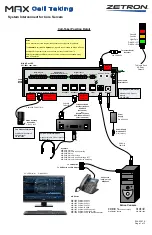
LAMBDA 10-2 OPERATION MANUAL – REV. 2.04 (20120224)
5
However, you must
you must
you must
you must only use shutters installed by Sutter Instrume
only use shutters installed by Sutter Instrume
only use shutters installed by Sutter Instrume
only use shutters installed by Sutter Instrument.
nt.
nt.
nt. This upgrade is
available only at Sutter Instrument’s factory (or through their distributors) and is listed as
“SHUTTER” in the Sutter catalogue (or “WHEEL” in older catalogues).
1.2.6
1.2.6
1.2.6
1.2.6
Adapters
Adapters
Adapters
Adapters
Most microscopes, cameras, light sources and other optical instruments to which the Lambda
10-2 may be interfaced will require some sort of adapter to link the devices. Adapters for
interfacing the filter wheel to most instruments are available from Sutter Instrument or can
be custom built by Sutter Instrument. Suitable adapters are available from other sources,
Suitable adapters are available from other sources,
Suitable adapters are available from other sources,
Suitable adapters are available from other sources,
as well, but Sutter Instrument assumes no responsibility for the performance, suitability
as well, but Sutter Instrument assumes no responsibility for the performance, suitability
as well, but Sutter Instrument assumes no responsibility for the performance, suitability
as well, but Sutter Instrument assumes no responsibility for the performance, suitability
and safety of adapters built by the user or other manufacturers.
and safety of adapters built by the user or other manufacturers.
and safety of adapters built by the user or other manufacturers.
and safety of adapters built by the user or other manufacturers.
1.2.7
1.2.7
1.2.7
1.2.7
Other and Optional Acce
Other and Optional Acce
Other and Optional Acce
Other and Optional Accessories
ssories
ssories
ssories
1.2.7.1
Liquid Light Guide (LLG)
A 2-meter, 3mm diameter liquid light guide is optionally available from Sutter Instrument
(P/N: LLG). The LLG includes a C-mount, lens, and lens tube.
1.3
1.3
1.3
1.3
Functional Description
Functional Description
Functional Description
Functional Description
1.3.1
1.3.1
1.3.1
1.3.1
Stepping Motor Operation
Stepping Motor Operation
Stepping Motor Operation
Stepping Motor Operation
Stepping motors are not as familiar to most people as the common DC motor, but there are
some similarities. The DC motor consists of an armature, an electromagnet mounted on a
rotating shaft, which is located inside a permanent magnet. Current is supplied to the
electromagnet through brushes that rub on contacts on the armature. When the
electromagnet is energized, the armature rotates to align the poles of the electromagnet with
the opposite poles of the permanent magnet. Of course, before this can occur, the rotation of
the armature changes the contact plates rubbing on the brushes so that the current is
reversed. This causes the poles of the electromagnet to reverse, establishing a force for
continued rotation. This switching action is called commutation.
In stepping motors, the rotating element, called a rotor, is generally a permanent magnet
while the fixed element, the stator, is the electromagnet. The key difference between
stepping motors and DC motors, however, is the method of commutation. The DC motor
commutates automatically as it rotates. Thus, the timing of the commutation is determined
by the speed of rotation, which may vary with the load or applied power. The commutation of
the stepping motor is set by external electronics, forcing the motor to rotate at a
predetermined rate. If the load is such that the motor does not have the force to produce the
correct rate of rotation, the rotation will become erratic and may even reverse.
The force exerted between two magnet poles is proportional to the square of the distance
between the poles. A motor with a single electromagnet and only two poles would exhibit
considerable loss of power when the distance between the poles of the permanent magnet
and the electromagnet was greatest. It is understandable that, in most practical DC motors,
the armature has more than two poles. This allows the commutation to occur over a smaller
angle of rotation, so that the active poles can always be relatively close to the poles of the
permanent magnet.














































